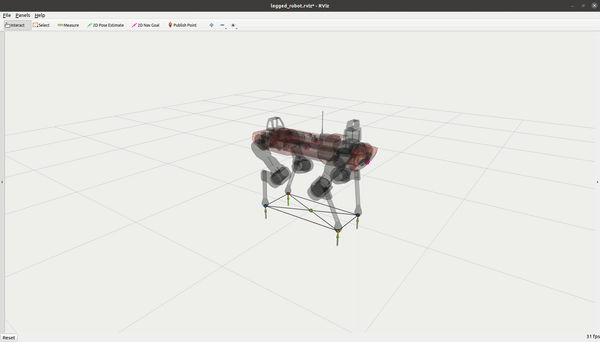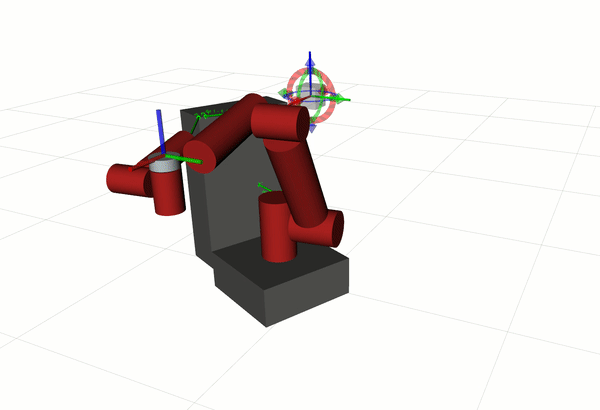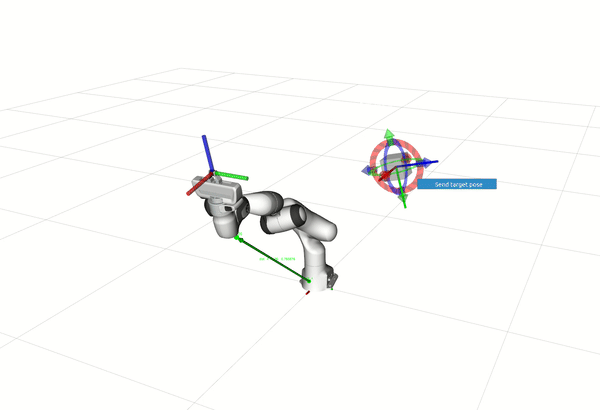Robotic Examples¶
OCS2 includes several robotic examples. We here briefly discuss the main features of each example.
System |
State Dim. |
Input Dim. |
Constrained |
Caching |
|---|---|---|---|---|
Double Integrator |
2 |
1 |
No |
No |
Cartpole |
4 |
1 |
Yes |
No |
Ballbot |
10 |
3 |
No |
No |
Quadrotor |
12 |
4 |
No |
No |
Mobile Manipulator |
6-13 |
6-13 |
Yes |
Yes / No |
Legged Robot |
24 |
24 |
Yes |
No |
For all these robotic examples, there are two separate packages:
ocs2_<robot>: Provides the library with the robot-specific MPC implementation.
ocs2_<robot>_ros: Wraps around the MPC implementation with ROS to define ROS nodes.
Double Integrator¶
The double integrator example is our simplest problem. It models a 1D point mass that moves in the x-direction. The model is linear, and the cost function is quadratic. The target point is set to the quadratic cost through a reference manager module.
# Build the example
catkin build ocs2_double_integrator_ros
# Source workspace
# Do not forget to change <...> parts
source <directory_to_ws>/<catkin_ws_name>/devel/setup.bash
# Launch the example
roslaunch ocs2_double_integrator_ros double_integrator.launch
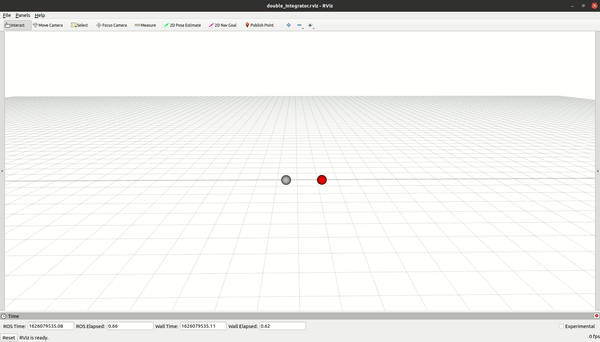
Cartpole¶
The cartpole example is a classic control problem where a pole is attached through an unactuated joint to a cart. The car moves along a frictionless track. The goal is to swing up and balance the pendulum starting from the downright position by accelerating a decelerating the cart along the track while respecting the input limits.
# Build the example
catkin build ocs2_cartpole_ros
# Source workspace
# Do not forget to change <...> parts
source <directory_to_ws>/<catkin_ws_name>/devel/setup.bash
# Launch the example
roslaunch ocs2_cartpole_ros cartpole.launch
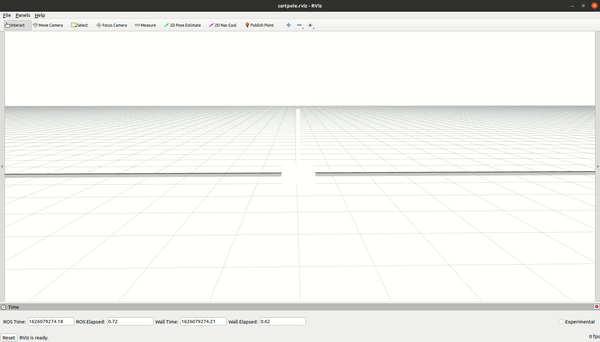
Ballbot¶
The Ballbot example is a 5DoF system. The platform is a torque-controlled, omnidirectional robot that balances on a ball through three omni-wheels. The system has nonlinear dynamics and exhibits non-minimum-phase behavior. The system dynamics is based on the Ballbot’s forward dynamics, and the linear approximation of the flow-map is calculated through auto differentiation. The task objective is to control the robot’s XY position and yaw based on user command.
# Build the example
catkin build ocs2_ballbot_ros
# Source workspace
# Do not forget to change <...> parts
source <directory_to_ws>/<catkin_ws_name>/devel/setup.bash
# Launch the example
roslaunch ocs2_ballbot_ros ballbot.launch

Quadrotor¶
The quadrotor example is a 6DoF system. The platform is modeled as a floating-base, rigid-body dynamics with a 3D moment and 1D force control in the normal direction to the robot. The system dynamics and its derivative are code generated. This example aims to track the user command defined as the quadrotor’s 3D position and yaw.
# Build the example
catkin build ocs2_quadrotor_ros
# Source workspace
# Do not forget to change <...> parts
source <directory_to_ws>/<catkin_ws_name>/devel/setup.bash
# Launch the example
roslaunch ocs2_quadrotor_ros quadrotor.launch

Mobile Manipulator¶
The mobile manipulator example is a fully kinematic problem. The model consists of a 6DOF arm plus 2D position and heading of the mobile base. The control inputs are the 6 joint velocities of the arm and the forward and rotational velocities of the base. The objective of the task is to track a 6DoF end-effector pose. The joint position and velocity limits are included in the constraint of the optimal control problem. Self-collision avoidance is achieved based on the collision bodies in the URDF model and collision avoidance constraints (refer to ocs2_self_collision).
Note: This example implements both the cache and the non-cache variants of the MPC, which can be chosen through the usePreComputation flag in the config file.
The system model is determined by parsing the URDF and the task file. Currently, the following system models are supported:
Default (value: 0): The default system model obtained by parsing the URDF.
Actuated Dummy wheel-base (value: 1): Adds a dummy XY-Yaw joints to the model parsed from the URDF which are actuated under holonomic constraint (velocity-control). This is a model of a mobile-manipulator with a base controlled in SE(2).
Unactuated Dummy floating-base (value: 2): Adds a dummy XYZ-RPY joints to the model parsed from the URDF which are unactuated.
Actuated Dummy floating-base (value: 3): Adds a dummy XYZ-RPY joints to the model parsed from the URDF which are fully-actuated (velocity-control). This is a model of a mobile-manipulator with a base controlled in SE(3).
To play-around different model types, you can change the model-information in the task.info files.
# Build the example
catkin build ocs2_mobile_manipulator_ros
# Source workspace
# Do not forget to change <...> parts
source <directory_to_ws>/<catkin_ws_name>/devel/setup.bash
For several common robot manipulators, we provide examples on running them with OCS2. The steps taken to generate the robot model files (URDF) are available here.
For some of these examples, we fix certain joints present in the URDF (such as the gripper finger joints or wheel joints) through the model_information.removeJoints attribute in the task.info file. This allows simplifying the constructed Pinocchio model. Only for visualization purposes on rviz, the joints under removeJoints in the task.info are published at zero joint positions by the dummy simulation node .
Warning
For these examples, additional tuning of the MPC might be required to work on hardware. Additionally, for some of the examples, the collision meshes need to be simplified into primitive shapes (such as cylinders and boxes) to allow collision avoidance.
We welcome contributions from the community for these use-cases.
Kinova Jaco2¶
# For 6-Dof
roslaunch ocs2_mobile_manipulator_ros manipulator_kinova_j2n6.launch
# For 7-Dof
roslaunch ocs2_mobile_manipulator_ros manipulator_kinova_j2n7.launch
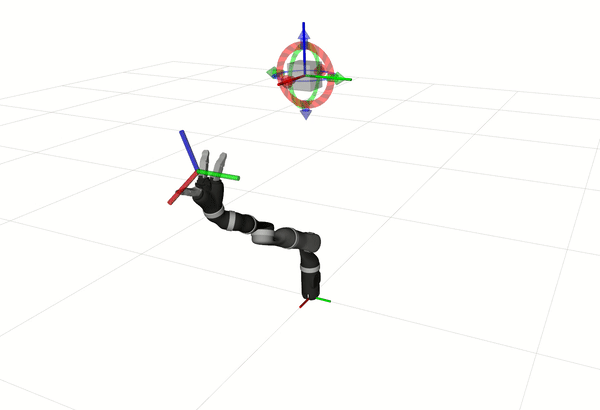
Clearpath Ridgeback with UR-5¶
roslaunch ocs2_mobile_manipulator_ros manipulator_ridgeback_ur5.launch
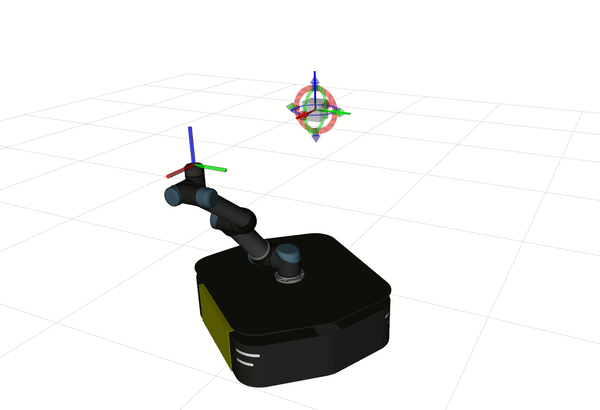
Legged Robot¶
The legged robot example is a switched system problem. It implements an MPC approach for motion control of a quadrupedal robot, Anymal. The robot’s gait is defined by the user and can be modified during the execution through a solver synchronized module (GaitReceiver). The mode sequence and the target trajectories are defined through a reference manager module (SwitchedModelReferenceManager). The cost function is a quadratic penalty to track the commanded base position and yaw and equally distribute the weight of the robot on the stance feet. The problem has several mode-depended constraints, such as zero force for the swing feet and zero velocity for the stance feet. The friction cone is enforced on the contact forces, and to avoid foot scuffing, the swing feet track a predefined motion in the z-direction.
The system dynamics are modeled in two ways which can be chosen from the config file: (1) The single rigid body dynamics (SRBD): This model assumes that the system has constant inertia regardless of its joint positions. It also includes the full kinematics of the system (2) The full centroidal dynamics (FCD): This model uses the centroidal dynamics, which incorporates the motion of the robot’s limbs. Similar to SRBD, it considers the full kinematics of the robot.
# Build the example
catkin build ocs2_legged_robot_ros
# Source workspace
# Do not forget to change <...> parts
source <directory_to_ws>/<catkin_ws_name>/devel/setup.bash
# Launch the example for DDP
roslaunch ocs2_legged_robot_ros legged_robot_ddp.launch
# OR launch the example for SQP
roslaunch ocs2_legged_robot_ros legged_robot_sqp.launch
